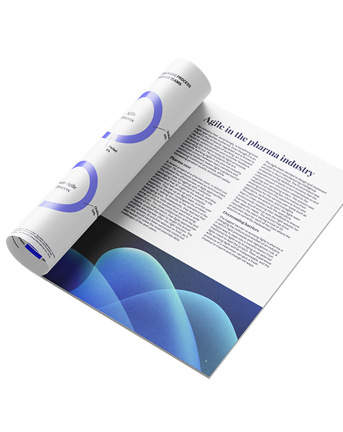What can you expect to learn from this article?
-
1
We present a case of the use of agility in the pharma industry, and the results of this case.
-
2
We discuss the biggest barriers to working agile, and how to overcome them now and going forward.
Teamwork, flexibility, and being adaptable to changes are all ingredients in a recipe for success and are also the key characteristics of a modern way of working called Agile. By 2020, 7/10 companies have adopted Agile approaches in some manner. Agility not only increases success rates in software development, but also quality, speed, and work culture.
Companies working Agile experience higher customer satisfaction, faster time-to-market delivery, reduced development costs, and more than 90% employee engagement. Along comes almost a doubling of requests for people with Agile skills from 2019 to 2020.
In times where digitalization and IT development are on top of many businesses’ agendas, Agile is proving to be of value and a great tool to facilitate change. But is it even possible to work Agile in an industry, like pharma, with standards and regulations?
Surprisingly, Agile approaches are proving to be enormously beneficial in the pharma industry. Even though it is an industry that is heavily regulated and is known to rely on traditional ways of working, an increased focus on communication and customer feedback is driving the industry towards Agile processes. According to our 7N consultants that are currently working Agile in the pharma industry, the close contact between team members and continuous feedback makes Agile a great tool for optimizing traditional processes, while increasing product quality and patient safety.
Pharma case
A recent project at a pharma client, in which one of our 7N consultants operated as technical lead, confirmed the effectiveness of Agile approaches. The client was struggling with ineffective packaging lines for finished products, and they speculated that AI might be the answer to the problem and had come up with a complex solution. They set up an Agile team, and the user experience designer investigated the problem further by talking directly to the operators of the packaging lines. Consequently, they learned that the operators’ daily operation involved a wide array of different systems that were slowing them down. The close collaboration with the end users of the final product, that Agile approaches require, enabled the team to target the actual problem and thereby offer the right solution. The initial complex AI solution was put on hold, as it not only would have been extremely costly but also would not solve the most concrete daily challenges of the end users. The Agile team decided to design and implement an end-to-end manufacturing intelligence solution in Azure Cloud.
The final product was presented on big dashboard screens that the operators could easily orient themselves on and collect relevant information related to the ongoing and upcoming orders. The solution was capable of presenting key information from existing production line systems to front-end applications for the various user types such as operators, technicians, and managers. Throughout the entire project, the Agile team kept in close contact with the operators, continuously receiving their feedback to ensure that they would end up with the right solution for their specific needs. The solution has since resulted in the client saving a total of 15 production days for each of the lines where the solution is currently implemented.
Overcoming barriers
The biggest barrier to working Agile in pharma is changing the culture and mindset of an industry in which rigid processes and regulations rule. A helpful way to ease into a transformation from traditional to Agile is by bringing in an external Agile coach to lead the project. Their experience with working Agile will be indispensable, and the presence of a newcomer can give a fresh impetus to inspire and change old ways.
Like the text illustrates, working Agile in the pharma industry is entirely possible. Most often, it just means that you will have to add additional layers to your Agile approach, such as multiple levels of automated testing and full traceability on all elements of the process from features to code, infrastructure, deployment, and test. Furthermore, the close contact between the team and the end users is an enormous advantage when products are being made for patients, as it allows them to have a voice throughout the process.
If you want to know more, read our report on this topic.


